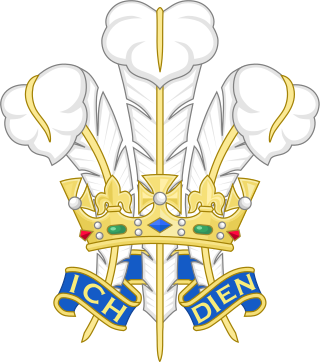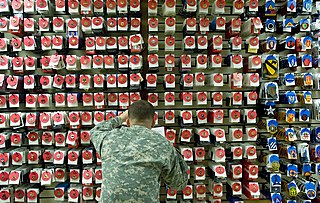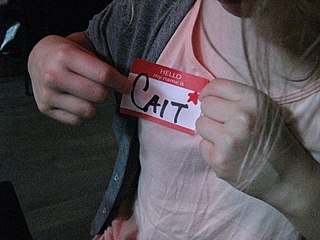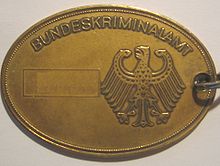Patch collecting or badge collecting is the hobby of collecting patches or badges.

The Most Excellent Order of the British Empire is a British order of chivalry, rewarding contributions to the arts and sciences, work with charitable and welfare organizations, and public service outside the civil service. It was established on 4 June 1917 by King George V and comprises five classes across both civil and military divisions, the most senior two of which make the recipient either a knight if male or dame if female. There is also the related British Empire Medal, whose recipients are affiliated with, but not members of, the order.

A button is a fastener that joins two pieces of fabric together by slipping through a loop or by sliding through a buttonhole.

A livery is an identifying design, such as a uniform, ornament, symbol or insignia that designates ownership or affiliation, often found on an individual or vehicle. Livery often includes elements of the heraldry relating to the individual or corporate body featured in the livery. Alternatively, some kind of a personal emblem or badge, or a distinctive colour, is featured.

A lanyard is a length of cord, webbing, or strap that may serve any of various functions, which include a means of attachment, restraint, retrieval, activation, and deactivation. A lanyard is also a piece of rigging used to secure or lower objects aboard a ship.

A cap badge, also known as head badge or hat badge, is a badge worn on uniform headgear and distinguishes the wearer's nationality and/or organisation. The wearing of cap badges is a convention commonly found among military and police forces, as well as uniformed civilian groups such as the Boy Scouts, civil defence organisations, ambulance services, customs services, fire services etc.
Officer Cadet is a rank held by military cadets during their training to become commissioned officers. In the United Kingdom, the rank is also used by members of University Royal Naval Units, University Officer Training Corps and University Air Squadron; however, these are not trainee officers with many not choosing a career in the armed forces.

Mess dress uniform is the most formal type of evening-wear uniform used by military personnel, police personnel, and other uniformed services members. It frequently consists of a mess jacket, trousers, white dress shirt and a black bow tie, along with orders and medals insignia. Design may depend on regiment or service branch, e.g. army, navy, air force, marines, etc. In modern Western dress codes, mess dress uniform is the supplementary alternative equivalent to the civilian black tie for evening wear. Mess dress uniforms are typically less formal than full dress uniform, but more formal than service dress uniform.

Identification badges of the uniformed services of the United States are insignia worn by service members conducting special duties, many of which can be awarded as permanent decorations if those duties are performed successfully. There are a few identification badges that are awarded to all services, others are specific to a uniform service. The Office of the President and Vice President and department/service headquarters badges are permanent decorations for those who successfully serve in those assignments. Some of the service level identification badges can be permanent decorations and others are only worn by a service member while performing specific duties, such as the Military Police Badge.

A heraldic badge, emblem, impresa, device, or personal device worn as a badge indicates allegiance to, or the property of, an individual, family or corporate body. Medieval forms are usually called a livery badge, and also a cognizance. They are para-heraldic, not necessarily using elements from the coat of arms of the person or family they represent, though many do, often taking the crest or supporters. Their use is more flexible than that of arms proper.
A rosette is a small, circular device that is typically presented with a medal. The rosettes are either worn on the medal to denote a higher rank, or for situations where wearing the medal is deemed inappropriate, such as on a suit. Rosettes are issued to those awarded a knighthood or damehood in a chivalric order, as well as state orders in nations such as Belgium, France, Italy and Japan, among others. Certain hereditary societies, such as the Society of Descendants of the Latin Kingdom of Jerusalem, as well as some fraternal orders issue rosettes to their members as well.

A distinctive unit insignia (DUI) is a metallic heraldic badge or device worn by soldiers in the United States Army. The DUI design is derived from the coat of arms authorized for a unit. DUIs may also be called "distinctive insignia" (DI) or, imprecisely, a "crest" or a "unit crest" by soldiers or collectors. The U.S. Army Institute of Heraldry is responsible for the design, development and authorization of all DUIs.

A livery collar or chain of office is a collar or heavy chain, usually of gold, worn as insignia of office or a mark of fealty or other association in Europe from the Middle Ages onwards.

Scouting memorabilia collecting is the hobby and study of preserving and cataloging Boy Scouting and Girl Guiding items for their historic, aesthetic and monetary value. Since collecting depends on the interests of the individual collector, the depth and breadth of each collection varies. Some collectors choose to focus on a specific subtopic within their area of general interest, for example insignia issued prior to the 1970s Boy Scouts of America requirement that all insignia have either the fleur-de-lis or the acronym BSA; or only the highest ranks issued by each nation. Others prefer to keep a more general collection, accumulating any or all Scouting merchandise, or Scouting stamps from around the world.

The custodian helmet is a type of helmet worn predominantly by male police officers in the United Kingdom and within certain other places around the world. First used by the Metropolitan Police in London in 1863, the BBC labelled the custodian helmet a "symbol of British law enforcement". They are worn by male constables and sergeants on foot patrol. A cultural icon, it has featured in films, TV series and other media involving British police.

A lapel pin, also known as an enamel pin, is a small pin worn on clothing, often on the lapel of a jacket, attached to a bag, or displayed on a piece of fabric. Lapel pins can be ornamental or can indicate the wearer's affiliation with a cause or an organization, such as a fraternal order or religious order; in the case of a chivalric order, the lapel pin is in the form of a rosette. Before the popularity of wearing lapel pins, boutonnières were worn.

A name tag is a badge or sticker worn on the outermost clothing as a means of displaying the wearer's name for others to view.

An embroidered patch, also known as a cloth badge, is a piece of embroidery which is created by using a fabric backing and thread. The art of making embroidered patches is an old tradition and was done by hand. During the first half of the twentieth century they were commonly embroidered using a shiffli embroidery machine. High-speed, computerized machines have led to mass production.

The Singapore Police Force has employed several different styles of uniforms throughout its history. Since 1969 it has used dark blue for its uniforms, although the first police uniforms introduced in 1856 were also in the same colour.
Police uniforms in the United States vary widely due to the nation's tradition of highly decentralized law enforcement. Over time, however, a number of general conventions and styles have become representative of American police fashion. Police officers wear uniforms to deter crime by establishing a visible presence while on patrol, to make themselves easily identifiable to non-police officers or to their colleagues who require assistance, and to quickly identify each other at crime scenes for ease of coordination.
























